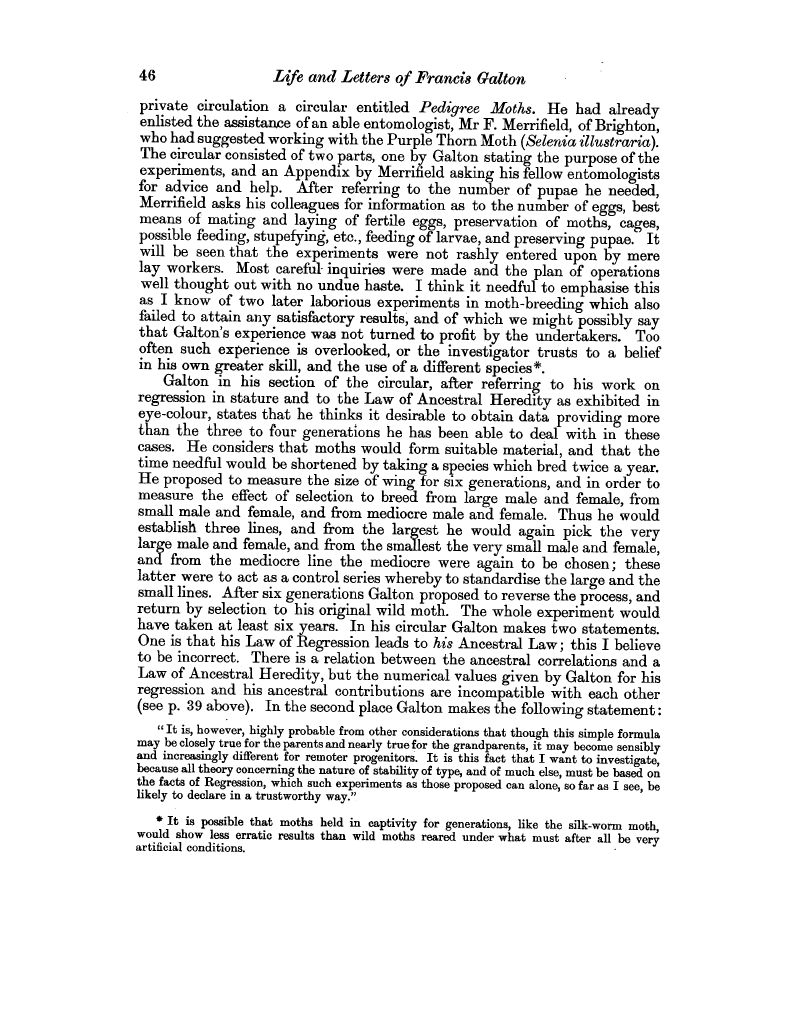| ||||||

OCR Rendition - approximate
46 Life and Letters of Francis Galton private circulation a circular entitled Pedigree Moths. He had already enlisted the assistance of an able entomologist, Mr F. Merrifield, of Brighton, who had suggested working with the Purple Thorn Moth (Selenia illustraria). The circular consisted of two parts, one by Galton stating the purpose of the experiments, and an Appendix by Merrifield asking his fellow entomologists for advice and help. After referring to the number of pupae he needed, Merrifield asks his colleagues for information as to the number of eggs, best means of mating and laying of fertile eggs, preservation of moths, cages, possible feeding, stupefying, etc., feeding of larvae, and preserving pupae. It will be seen that the experiments were not rashly entered upon by mere lay workers. Most careful- inquiries were made and the plan of operations well thought out with no undue haste. I think it needful to emphasise this as I know of two later laborious experiments in moth-breeding which also failed to attain any satisfactory results, and of which we might possibly say that Galton's experience was not turned to profit by the undertakers. Too often such experience is overlooked, or the investigator trusts to a belief in his own greater skill, and the use of a different species*. Galton in his section of the circular, after referring to his work on regression in stature and to the Law of Ancestral Heredity as exhibited in eye-colour, states that he thinks it desirable to obtain data providing more than the three to four generations he has been able to deal with in these cases. He considers that moths would form suitable material, and that the time needful would be shortened by taking a species which bred twice a year. He proposed to measure the size of wing for six generations, and in order to measure the effect of selection to breed from large male and female, from small male and female, and from mediocre male and female. Thus he would establish three lines, and from the largest he would again pick the very large male and female, and from the smallest the very small male and female, and from the mediocre line the mediocre were again to be chosen; these latter were to act as a control series whereby to standardise the large and the small lines. After six generations Galton proposed to reverse the process, and return by selection to his original wild moth. The whole experiment would have taken at least six years. In his circular Galton makes two statements. One is that his Law of Regression leads to his Ancestral Law; this I believe to be incorrect. There is a relation between the ancestral correlations and a Law of Ancestral Heredity, but the numerical values given by Galton for his regression and his ancestral contributions are incompatible with each other (see p. 39 above). In the second place Galton makes the following statement °1 It is, however, highly probable from other considerations that though this simple formula may be closely true for the parents and nearly true for the grandparents, it may become sensibly and increasingly different for remoter progenitors. It is this fact that I want to investigate, because all theory concerning the nature of stability of type, and of much else, must be based on the facts of Regression, which such experiments as those proposed can alone, so far as I see, be likely to declare in a trustworthy way." * It is possible that moths held in captivity for generations, like the silk-worm moth, would show less erratic results than wild moths reared under what must after all be very artificial conditions.
|